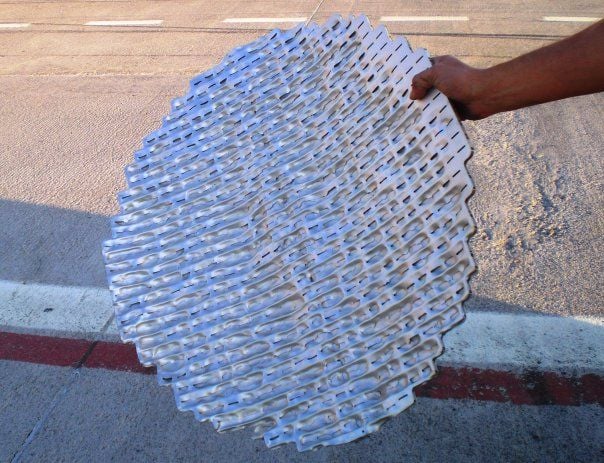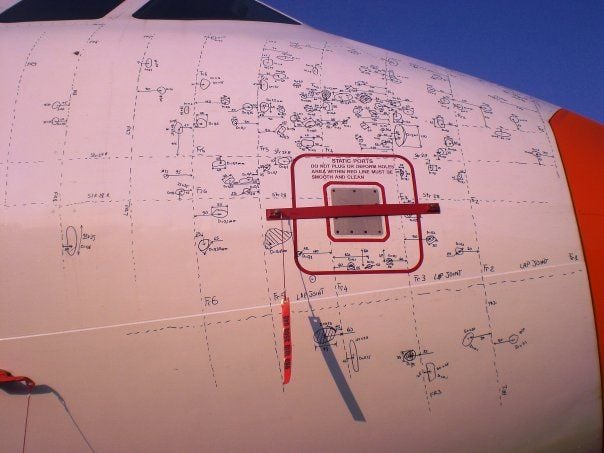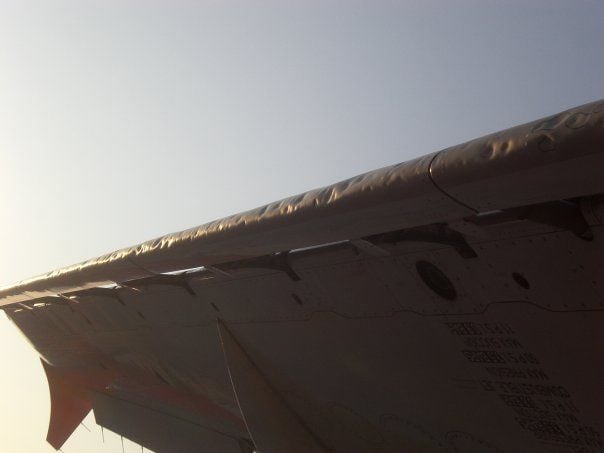Austrian A320 hail encounter near VIE
The pitot probes are sized to be well outside of the (normal) boundary layer effects. Even with a seriously screwed up flow from the damaged radome, I wouldn't expect a big effect on the sensed total pressure (P2) as most of the low disruption would be closer to the body than the total probe. Static, on the other hand, might see some effects as the flow detaches/re-attaches which does some really weird things to the boundary layer.
When pushing a big non-airfoil shape through the air, there is not much "boundary" layer left, it's turbulence all over the place. Just find a location where the turbulence is minimal and the airflow is still representing the airflow the airfoils experience.
Join Date: Mar 2006
Location: Vance, Belgium
Age: 62
Posts: 284
Likes: 0
Received 24 Likes
on
11 Posts
So this strategy is based on reducing the charge bearers and is kind of opposite to the weather radar strategy which is reducing the mean free path of bearers.
I remember that, almost 40 years ago, we naively thought that applying the corona discharge formula (formula giving the electric field strength given the potential difference and the shape (radius) of the conducting surface) on the density achieved by the pumps and on the particular shape of the duct would protect us against arcing breakdown.
That was wrong.
Actually, the variation (pulsing) of the energy transported by the radio wave and the existence of a standing wave, even a low one, introduced points where local surface currents were heating the metal, thus producing metal vapours, thus locally reducing the level of vacuum, thus creating the conditions for a local arcing breakdown.
Forensic investigations would clearly show where the breakdowns were initiated without letting us know why it happened there.
We resorted to designing by experiments and applying a large safety margin.
I just found out on Google Scholar that several analytical methods have been designed and proofed in the years 2000-2010.
That's great.
The following 2 users liked this post by Luc Lion:
The boundary layer is defined as the region from the 'no slip' condition at the surface to the basically non-effected condition of the free stream. So long as a body is in motion, it always exists - although it's specific characteristics and thickness can be all over the map depending on velocity and shape of the body moving through the airstream.
Part of that is the 'laminar' vs. 'turbulent' boundary layer - and while conventional thinking says a laminar boundary layer is better, that is often not the case since laminar is more subject to flow separation than a turbulent condition - and separation is generally higher drag (see the dimpled golf ball for one example of turbulent being better). The boundary layer almost inevitably increases in thickness as you go aft on the fuselage - getting relatively large towards the tail (you may notice some aircraft don't bother to use flush mount rivets near the back since the boundary layer is so thick the flush rivets don't really make any difference) -which is why pitot probes are nearly always near the nose.
Pitot tubes are sized to be outside the boundary layer to measure a representative total pressure (P2). While there is often some small position correction added it (usually to correct for airflow not being perfectly perpendicular to the probe), the key word here is small. Some aircraft use statics incorporated into the Pitot probes, others use 'salt shaker' surface ports. Static is not nearly as clean a measurement, as it can be significantly affected by local curvature of the surface where the port is located (hence the need for position corrections - sometimes large), and static measurements can be greatly affected by flow discontinuities - such as what you get with areas of supersonic flow (if you really want to foul up a static measurement, let a shock wave form right on top of the static port
 ).
).I don't know what static system is used on the A320 (there is no 'right' answer - it basically comes down to designer preference).
There is no question that the damaged radome would cause a large increase in the thickness and disruption of the boundary layer compared to the clean configuration. However I'd expect the pitot probes to be outside of the worst boundary layer disruption and hence the P2 measurement would not be greatly affected (however potential damage to the probes by the heavy hail is a different question that I can't speak to). Static pressure is a different can of worms, with the answer somewhat dependent on the probe system that's used on the A320.
But even if only one of the total and static pressure measurements is affected, you're going to have an indeterminate effect on indicated airspeed.
-
The boundary layer is defined as the region from the 'no slip' condition at the surface to the basically non-effected condition of the free stream. So long as a body is in motion, it always exists - although it's specific characteristics and thickness can be all over the map depending on velocity and shape of the body moving through the airstream.
Part of that is the 'laminar' vs. 'turbulent' boundary layer - and while conventional thinking says a laminar boundary layer is better, that is often not the case since laminar is more subject to flow separation than a turbulent condition - and separation is generally higher drag (see the dimpled golf ball for one example of turbulent being better). The boundary layer almost inevitably increases in thickness as you go aft on the fuselage - getting relatively large towards the tail (you may notice some aircraft don't bother to use flush mount rivets near the back since the boundary layer is so thick the flush rivets don't really make any difference) -which is why pitot probes are nearly always near the nose.
Pitot tubes are sized to be outside the boundary layer to measure a representative total pressure (P2). While there is often some small position correction added it (usually to correct for airflow not being perfectly perpendicular to the probe), the key word here is small. Some aircraft use statics incorporated into the Pitot probes, others use 'salt shaker' surface ports. Static is not nearly as clean a measurement, as it can be significantly affected by local curvature of the surface where the port is located (hence the need for position corrections - sometimes large), and static measurements can be greatly affected by flow discontinuities - such as what you get with areas of supersonic flow (if you really want to foul up a static measurement, let a shock wave form right on top of the static port ).
).
The boundary layer is defined as the region from the 'no slip' condition at the surface to the basically non-effected condition of the free stream. So long as a body is in motion, it always exists - although it's specific characteristics and thickness can be all over the map depending on velocity and shape of the body moving through the airstream.
Part of that is the 'laminar' vs. 'turbulent' boundary layer - and while conventional thinking says a laminar boundary layer is better, that is often not the case since laminar is more subject to flow separation than a turbulent condition - and separation is generally higher drag (see the dimpled golf ball for one example of turbulent being better). The boundary layer almost inevitably increases in thickness as you go aft on the fuselage - getting relatively large towards the tail (you may notice some aircraft don't bother to use flush mount rivets near the back since the boundary layer is so thick the flush rivets don't really make any difference) -which is why pitot probes are nearly always near the nose.
Pitot tubes are sized to be outside the boundary layer to measure a representative total pressure (P2). While there is often some small position correction added it (usually to correct for airflow not being perfectly perpendicular to the probe), the key word here is small. Some aircraft use statics incorporated into the Pitot probes, others use 'salt shaker' surface ports. Static is not nearly as clean a measurement, as it can be significantly affected by local curvature of the surface where the port is located (hence the need for position corrections - sometimes large), and static measurements can be greatly affected by flow discontinuities - such as what you get with areas of supersonic flow (if you really want to foul up a static measurement, let a shock wave form right on top of the static port
 ).
).Disturb the airflow significantly in front of the pitot tubes and suddenly the pitot tubes are no longer in (relatively) undisturbed air(flow) and the readings go unpredictable all over the place.
Static is also difficult, since it can even suffer from lower pressure areas. So, when the designers don't find a suitable location on the aircraft surface, an alternative can be the combi probes.
There is no question that the damaged radome would cause a large increase in the thickness and disruption of the boundary layer compared to the clean configuration. However I'd expect the pitot probes to be outside of the worst boundary layer disruption and hence the P2 measurement would not be greatly affected (however potential damage to the probes by the heavy hail is a different question that I can't speak to).
Static pressure is a different can of worms, with the answer somewhat dependent on the probe system that's used on the A320.
But even if only one of the total and static pressure measurements is affected, you're going to have an indeterminate effect on indicated airspeed.
But even if only one of the total and static pressure measurements is affected, you're going to have an indeterminate effect on indicated airspeed.
Just to be sure, I don't say, the measurements in a disrupted situation can not be used to fly the aircraft, though cat-III&autoland&co, I think, that's no longer possible.
Join Date: Jul 2000
Location: Austria
Age: 63
Posts: 67
Likes: 0
Received 0 Likes
on
0 Posts
It seems that some individual saw fit to report the crew of this flight to the authorities, citing reckless endangerment of transport ("Fahrlässige Transportgefährdung"). As the thunderstorm cloud was situated in the court district of Graz, the local state attorney has taken it upon himself to investigate the issue.
What this is supposed to achieve is beyond me - some inter-authority competency struggle is to be expected though. Iin any case, the Austrian Accident investigation authority that has taken interest in this flight already is bound by EU regulation 996/2010 . They are consequently prohibited from handing over anything they might have gathered as pertinent to the case over to anybody else for any other purpose, obviously including a criminal investigation.
I do hope that the elementary, fundamentally important principle of searching for causes instead of apportioning blame will prevail here. Safety is not at all enhanced by short-sightedly piling blame upon directly involved personnel, as a penal court is wont to do. This is exclusively the job of an investigation committee that will painstakingly pick through and document anything that may have contributed to an occurence.
What this is supposed to achieve is beyond me - some inter-authority competency struggle is to be expected though. Iin any case, the Austrian Accident investigation authority that has taken interest in this flight already is bound by EU regulation 996/2010 . They are consequently prohibited from handing over anything they might have gathered as pertinent to the case over to anybody else for any other purpose, obviously including a criminal investigation.
I do hope that the elementary, fundamentally important principle of searching for causes instead of apportioning blame will prevail here. Safety is not at all enhanced by short-sightedly piling blame upon directly involved personnel, as a penal court is wont to do. This is exclusively the job of an investigation committee that will painstakingly pick through and document anything that may have contributed to an occurence.








